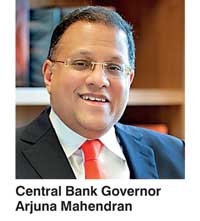Wednesday Dec 25, 2024
Wednesday Dec 25, 2024
Wednesday, 30 December 2015 00:49 - - {{hitsCtrl.values.hits}}
Reuters: Sri Lanka’s Central Bank is expected to raise interest rates by 25 basis points from record lows at its policy meeting on Wednesday, a Reuters poll found, a move that could relieve pressure on the fragile rupee.
The rupee closed at a record low of 143.95/144.05 per dollar on Tuesday, hit by dollar demand from importers.
Six out of 11 economists surveyed expected the Central Bank of Sri Lanka to raise the standing deposit facility rate (SDFR) and the standing lending facility rate (SLFR) by 25 basis points to 6.25% and 7.75%, respectively.
It will be the first increase since February 2012, should the Central Bank raise rates on Wednesday.
All 11 economists predicted the statutory reserve ratio (SRR) for commercial banks would remain unchanged at 6.00%.
Four economists expected the rates to be left steady, while one expected the Central Bank to raise SDFR and SLFR by 50 basis points (bps) each.
“If they want to maintain the currency, they will have to raise the policy rates,” said Danushka Samarasinghe, research head at Softlogic Stockbrokers.
Sri Lanka has to raise rates to guard against outflows from the pressure of higher U.S. rates and cooling economic growth.
Economists said the government had little fiscal options to help keep the currency stable as it had promised a lot of spending in the 2016 budget.
Sri Lanka early this month passed its 2016 budget with a series of amendments due to public protests that could derail the government’s attempts at fiscal consolidation.
The Central Bank in April surprised markets with a 50-bp cut to spur economic growth and boost consumer prices. Until then, it had held rates steady for 14 months.
Since then the island nation has witnessed a 22.2% growth in private sector credit in September from a year earlier, compared with 13.9% growth in March this year.
The Central Bank floated the currency on 3 September after heavily defending it. Since then the currency has fallen 6.4% and economists say lack of monetary and fiscal policy tightening led to the steep fall, apart from the strong dollar.
The International Monetary Fund in September said that the key policy rates were not “necessarily inappropriate”.
Sri Lanka’s economy grew 4.8% in the third quarter of this year compared with the same period a year earlier, slowing from 6% in the second quarter.
Finance Minister Ravi Karunanayake during his 2016 budget speech last month estimated the economy would expand 6% this year and aimed to achieve annual growth of 7-8% during the next few years.